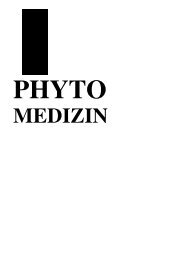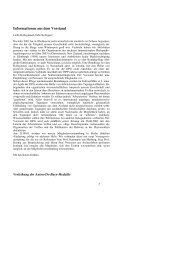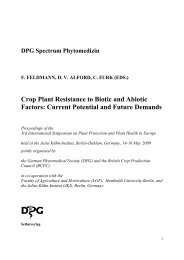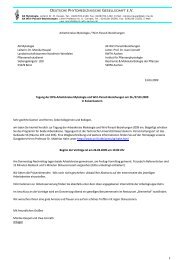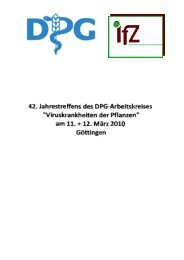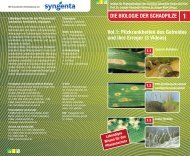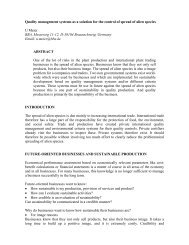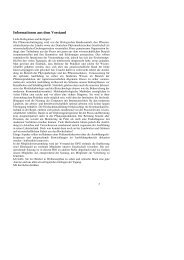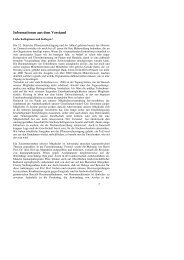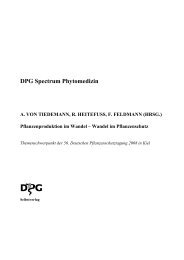PHYTO MEDIZIN Mitteilungen der Deutschen ... - Die DPG
PHYTO MEDIZIN Mitteilungen der Deutschen ... - Die DPG
PHYTO MEDIZIN Mitteilungen der Deutschen ... - Die DPG
Erfolgreiche ePaper selbst erstellen
Machen Sie aus Ihren PDF Publikationen ein blätterbares Flipbook mit unserer einzigartigen Google optimierten e-Paper Software.
ever, in Trialeurodes vaporariorum (a non vector of geminiviruses), wildtype<br />
WmCSV was detected in the midgut only, thus suggesting that the virus<br />
was not capable of crossing the gut wall. In contrast, in B. tabaci, the accessory<br />
and/or the primary salivary glands apparently present the significant<br />
epithelial barrier to virus transmission. Hence, for the begomovirus WmCSV<br />
and its whitefly vector, a pathway similar to the luteovirus / aphid translocation<br />
is expected. In immunolocalization studies with organs excised from<br />
viruliferous insects carrying wild type or non transmissible virus mutants, a<br />
specific labelling with WmCSV antiserum was obtained at the microvilli<br />
region of the epithelial cells of the gut wall food canal, indicating for putative<br />
virus adsorption sites or, for a putative receptor-mediated delivery to the<br />
hemoceol. Respective experiments carried out with primary and accessory<br />
salivary glands so far did not indicate for specific adhesion/entry sites into<br />
these organs.<br />
Recent developments in Augusta disease of tulip in the Netherlands<br />
VP Bijman, AFIM Derks and GJ Blom-Barnhoorn; Applied Plant Research, section<br />
Flower Bulbs, Lisse<br />
Augusta disease in tulips is caused by Tobacco necrosis virus (TNV). The<br />
virus is transmitted by zoospores of Olpidium brassicae. The host range of<br />
this fungus includes many commonly found weeds such as annual blue grass,<br />
annual sowthistle, chickweed, dandelion, shepherd’s purse and others. Some<br />
of these Olpidium brassicae hosts are also hosts of TNV. Damage caused by<br />
Augusta disease can be severe in the Netherlands. Disease incidence occurred<br />
up to 60% in fields in some years and up to 20 % in flower forcing. There has<br />
been a shift in tulip bulb production on sandy soils towards production on<br />
heavy clays. Since Olpidium brassicae is spread by water and clay soils are<br />
more sensitive to standing water, the occurrence and establishment of the<br />
disease is enforced. As a common practice in certain areas, bulbs are grown<br />
on soils, which have been in pasture for a period of circa 6 years. These pastures<br />
are a favourable environment to enhance the spread of Olpidium brassicae.<br />
The influence of soil type, plant debris and planting time are examined.<br />
The addition of Pseudomonas to the bulb dipping bath with fungicides leads<br />
to a significant decrease of Augusta. Preliminary results suggest that incorporating<br />
Sarepta mustard in the soil might prevent the occurrence of Augusta<br />
disease. Several other crops are currently un<strong>der</strong> investigation. The fungus<br />
Olpidium brassicae can be detected with the aid of PCR in soils and in closed<br />
water supply systems. These methods will be applied in epidemiological<br />
studies.<br />
22



